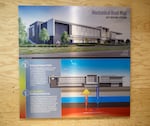
Thom Darrah oversees the hot and cold water system that brings geothermal heat to Oregon's Tech's new engineering building on Sept 26, 2023.
Kristian Foden-Vencil / OPB
Back in the 1960s, the Oregon Institute of Technology was looking for somewhere to build a new campus.
School leaders picked a spot on the northeast corner of Klamath Falls, with one very unusual feature.
“The site was actually selected because they had noticed that the snow would melt sooner here than other places in town,” said college facilities director Thom Darrah.
Oregon Tech administrators wanted to showcase the emerging technology of geothermal energy, essentially a process in which hot water hidden deep underground is brought up to the surface and put through heat exchangers to warm buildings.
Oregon Tech bought the land and drilled 2,000 feet into the rock — the equivalent of 185 stories down — to a deposit of water that measured 196 degrees Fahrenheit. That’s 16 degrees short of boiling.
Sixty years later, the water remains just as hot, and the Southern Oregon school still uses the clean, cheap energy to heat classrooms and dormitories; campus leaders estimate that saves them $1.4 million a year.
But there’s a problem: “Geothermal water is very corrosive,” Darrah said.
The school is in the process of replacing its old heat exchangers, valves and pipes at a cost of $18 million, which is being picked up by state taxpayers.
Such high maintenance costs — and the geographic availability of hot water — help explain why not everyone in Klamath Falls uses geothermal energy.

Geothermal energy system at Oregon Tech, Sept. 29, 2023.
Kristian Foden-Vencil / OPB
Residents in neighborhoods like Pacific Terrace and Hillside, on the northeast edge of Klamath Falls, have been tapping geothermal since the 1930s. But they lie on a fault line, meaning property owners only have to dig 100 to 400 feet to reach hot water. Homes sell for a premium of $10,000 to $30,000 over other neighborhoods in the Klamath Falls area because of the cheap energy.
Some consider geothermal energy to be more reliable than wind or solar energy because it’s constant, rather than dependent on atmospheric conditions.
But in a city of about 22,000 people, only about 600 Klamath Falls homes heat their homes geothermally. Ground temperatures have been mapped around town, but they’re not very accurate.
“That technology is advancing all the time,” said Darrah said.
“... At the end of the day, it’s a lottery. Are you drilling in the right place? And how deep do you have to go? And are you going to hit that geothermal resource at all?”
So most new construction here still goes with the more common technological bet: natural gas.

Ashley VanEssen has not tried to drill to find geothermal energy where she lives because it would likely be prohibitively expensive.
Kristian Foden-Vencil / OPB
Take Ashley VanEssen. She lives on the outskirts of Klamath Falls where there is no municipal drinking water. So she already has a shallow well.
“Out of our hose that you can use to wash your car, it’s a little bit warmer than you would have if you just started a faucet on regular tap water,” VanEssen said.
Their water contains a lot of minerals, and family members take jugs of it home, she said: “It’s actually delicious.”
But VanEssen hasn’t considered drilling deeper to see if good geothermal energy is available.
“To try to even hit geothermal … would just not be possible for a house that you’re trying to have cost savings on your drill,” she said.
Even a small geothermal well might cost $30,000 to drill. VanEssen heats her home with natural gas and electricity — a system that would cost about $6,000 to install.
The finances mean that it’s mainly just large institutions, like Oregon Tech or the city government, that have the deep pockets to tap geothermal.
Once in use, the resource is a real boost for the town. For example, the local outdoor pool is heated year-round.
“... You drive by it on one of our main streets, and you see steam coming off of the public pool,” VanEssen said. One local dairy used to pasteurize its milk with geothermal. Even some sidewalks and bridges are geothermally heated.
“It makes you want to go into the businesses when there’s not ice on the sidewalks,” VanEssen said.
The local library, schools, courthouse and Klamath Falls City Hall are all heated by the underground aquifer. The city even sells energy to a few downtown businesses.

Klamath Falls' geothermal system remains small because of the corrosive water, said Robbie West, who manages it for city. “The more that we expand our system, and the more we try to use it, the more it’s going to cost to maintain it,” West said. “And then that could drive the cost of our rates up.”
Kristian Foden-Vencil / OPB
But the geothermal system remains small because of the corrosive water, said Robbie West, who manages it for city.
“The more that we expand our system, and the more we try and use it, the more it’s going to cost to maintain it,” West said. “And then that could drive the cost of our rates up.”
Another key reason new subdivisions don’t install geothermal is the unique nature of each new system.
Unlike a gas furnace, which can be quickly fixed by local contractors, a geothermal system tends to require experts, new designs and extensive refurbishment.
“It’s a lot easier to work with an established utility company than to try to do a private (home owners association) thing,” West said.
So the town keeps the system small and tries to peg the rates to about the same cost as natural gas.
About 18 other U.S. cities have substantial geothermal projects, including Boise.
So while geothermal is a fascinating point of local pride for Klamath Falls — and even something many residents still enjoy — it’s not the energy panacea that it is in somewhere like Iceland, where 90% of homes are heated with geothermal energy.
